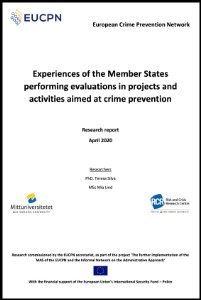Experiences of the Member States performing evaluations in projects and activities aimed at crime prevention
By Teresa Silva and Mia Lind.
The evaluation of crime prevention interventions involves the systematic collection and analysis of information about the changes that occur in the different components of a criminal problem produced by the activities of the intervention. The principal objective of analyzing such information is to determine at what level the goals were achieved, and at what cost. Different groups benefit from the results of the evaluations, including those who design and implement the intervention, managers, stakeholders, sponsors, policy advisors, target groups, etc. The information produced by the evaluation is useful for guiding decisions about how to redesign the intervention, how to orient the future allocation of resources, and how to advise on policy directions. Whether or not to use the results of the evaluation is ultimately a management decision, but professionals and evaluators are reinforced when they see that the effort they put in to evaluating the interventions is useful to introducing improvements. Evaluation entails important methodological aspects, and evaluation must be planned at the same time that the intervention is planned in order to ensure the intervention’s evaluability (i.e., the capacity to be evaluated in a reliable and credible manner). Misalignments between the crime problem, the objectives, and the activities that the intervention comprises result in low evaluability and might seriously compromise the quality of the evaluation. In this sense, evaluation is a tool that contributes to the design of the intervention.
Brussels: European Crime Prevention Network, 2020. 98p.


